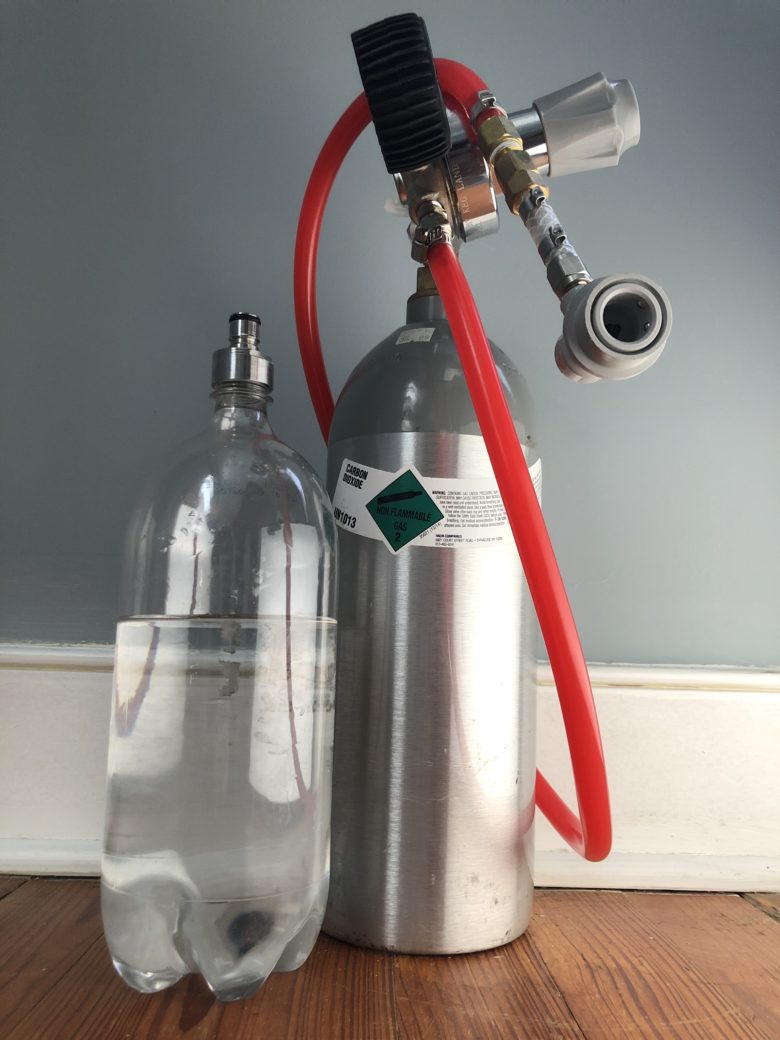EQUIPMENT:
Co2 dual/double gauge regulator
5/16” gas line with ball lock cornelius/corny keg assembly
5-10lb Co2 tank
Carbonating cap for plastic bottles and ball connectors
At least one (1) empty plastic two-liter bottle
PROCEDURE:
Fit the 5/16” gas line onto the output of the Co2 regulator, tightening with a flathead screwdriver. Remove the plastic safety cap from the threading on the Co2 tank and attach the Co2 regulator, ensuring the o-ring is engaged, threading with your fingers, then using an adjustable wrench to tighten. Open the valve on the Co2 tank slightly and listen for any leaks, make adjustments as needed. Fully open the valve on the Co2 tank and use the knob on front to adjust the output pressure to your desired psi (we generally carbonate most liquids at 40psi). Turn off gas using the valve on the Co2 tank until ready to use. This is your carbonating rig.
Fill an empty two-liter bottle with your desired liquid to carbonate, though we recommend starting with still water to get a feel for how the entire process works. You can fill the bottle all the way to the top, but we recommend filling it no more than ¾ full to allow for greater headroom and quicker carbonation. Screw on the carbonating cap to the top of the bottle, ensuring that it is not cross-threaded. Holding the two-liter bottle securely with one hand, pull the collar back on the corny keg assembly (the gray end of the gas line from the carbonating rig) and push it down onto the carbonating cap until the collar locks into place, holding securely with one hand on top of the carbonating cap and one hand under the bottle. You will hear, see, and feel an immediate rush of gas into the two-liter bottle.
It should also be apparent at this point if the carbonating cap is not properly attached to the two-liter bottle. Adjust as necessary.
Holding firmly, begin to shake the two-liter bottle back and forth to facilitate better carbonation. You will soon be able to tell when the solution is fully carbonated. Carefully remove the gas line assembly by pulling up on the collar and detaching. Turn off gas using the valve on the Co2 tank. Reserve.
To serve, gently and SLOWLY turn the carbonating cap to release the pressure from the two-liter bottle. Serve or enjoy immediately.
Stop spending money and stop wasting valuable resources on canned or bottled soda/seltzer water, and start making your own carbonated beverages. This rig will set you back around $100 or so, and it’ll cost around $30 each time you need to refill/exchange your Co2 tank (every few months or so), but you’ll be saving money in no time. Go to your local brewing supply store to buy all of this stuff; be a good person and support local businesses. Not only will they have all of the necessary equipment, but they’ll also have the technical know-how and any answers to any general questions you might have about the whole setup. That said, the carbonating caps might be a little more difficult to come by, but are readily available online (along with everything else, but seriously go to your local brewing supply store if you can).
A few tips for improved results and general success:
• Don’t carbonate anything hot. That’s dangerous.
• Don’t try to remove the carbonating cap too quickly. That’s dangerous.
• Keep a firm grip on the carbonating cap at all times when carbonating and opening the bottle.
• Cold liquids retain carbonation more effectively. The colder the solution prior to and during carbonation the better.
• Following that, while ice will help keep your beverage colder it will decrease carbonation more quickly. See below about fine straining.
• Carbonating solutions with alcohol (like a gin and tonic, hard seltzer, etc.) work best when at or below 15% ABV for the entire mixture. You can carbonate a beverage with a higher ABV, but your results may vary.
• Fine strain anything with particulate matter, sediment, etc. using a coffee filter (or two). Failure to do so will create unwanted nucleation points which will release carbonation more quickly.
• Along those lines, if you are adding sugar to a solution then make sure that it is completely dissolved, or consider using a 1:1 simple syrup in it’s place, doubling the amount used by weight since it’s only half sugar.
• Avoid solutions with any foaming properties, or at least be patient with them when releasing pressure. If your mixture has a layer of foam of bubbles on top then allow it to reabsorb back into the liquid. Again, be patient.
We’ll add some more as we think of them. But with that the possibilities are limitless:
• Bottomless soda water or seltzer. 40 psi is our go-to pressure, and results in a crisp, prickly body.
• Patch a flat soda, beer, or sparkling wine by giving it a shake in the rig. Hell, re-carbonate it at a higher psi (no more than 40 psi for safety and best results) if you’d like.
• Carbonate juice. Why not? Clarify it for better results.
• Put those last two ideas together and make super effervescent mimosa variants.
• Make some tight housemade sodas.
• Force carbonate kombucha to retain it’s natural fizziness.
• Carbonate leftover coffee with a little sugar and other flavors for a dope coffee soda.

